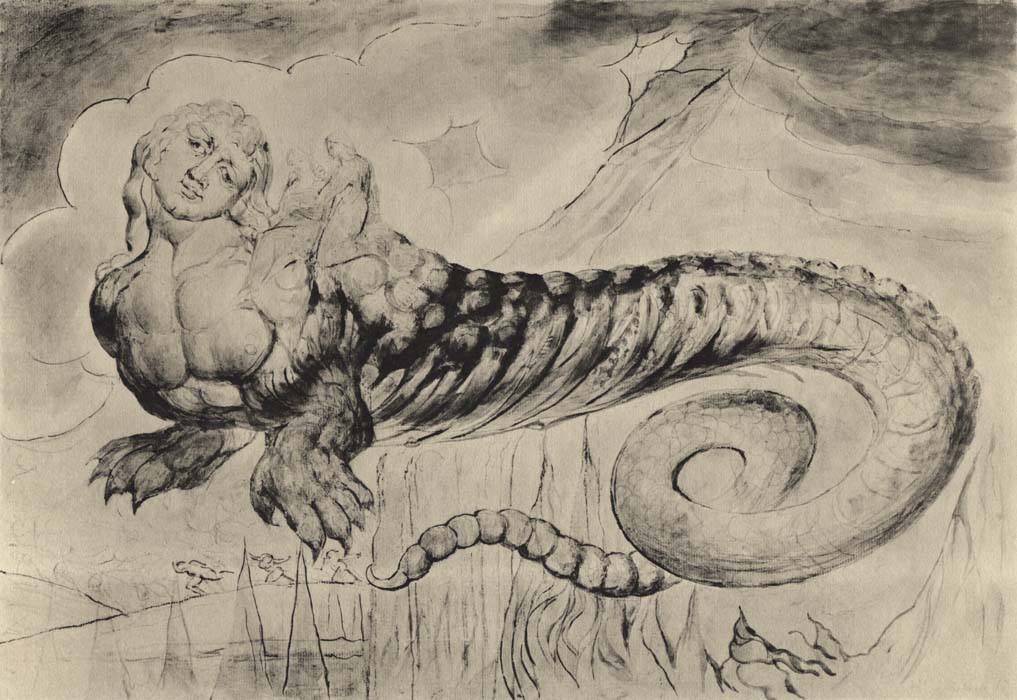La Dolce Vita and the Face of Fraud
Many have celebrated, and many have loathed, Fellini's modernist epic La Dolce Vita. It is a break from so much in Italy's past. It is Rome undone; the Rome of the new suburbs, not of the Roman ruins. Rome as prostitute with debauched suitors trying to win her love.But, would Dante find Fellini's Rome so different from his Rome or from his Florence? Indeed, how "dantean" is La Dolce Vita? Rather than focusing on the entire movie, which might be seen as Marcello's own descent through the levels of sin in Hell, without the promise of salvation, I would like to look at one scene the renders a final "dantean" judgment on the film. Of course this scene is at the end of the film when Marcello is in his moral free-fall.
The debauched party goers greet the arrival of dawn at the end of the revels by leaving their villa signorile to go out to the beach. Tired from their drinking, dancing, and "debauching" (three times that word already!), they see a group of men doing something novel....working. None of these elites actually has a job, beyond being gadflies, but these fishermen instead are working hard to pull in the bounty of the sea. What emerges from their efforts? A sea monster!
The huge sea monster is a marvel, a wonder. The fisherman swear that they will make a million off of it! The party goers are repulsed and attracted to the beast. Marcello in particular, can't take his eyes off of it, particularly of the all-too human large eyes. He says, "And how it insists on looking at you."
The creature from the deep with a human aspect that hides its monstrosity, reminds me of a central image in Dante's Hell. Geryon. This beast represents fraud. He has the fair face that hides a monstrous body. His face is a lie to hide the wickedness of his essence.
| E quella sozza imagine di froda | 17.7 | And he came on, that filthy effigy | |
| sen venne, e arrivò la testa e 'l busto, | of fraud, and landed with his head and torso | ||
| ma 'n su la riva non trasse la coda. | but did not draw his tail onto the bank. | ||
| La faccia sua era faccia d'uom giusto, | 17.10 | The face he wore was that of a just man, | |
| tanto benigna avea di fuor la pelle, | so gracious was his features' outer semblance; | ||
| e d'un serpente tutto l'altro fusto; | and all his trunk, the body of a serpent; | ||
| due branche avea pilose insin l'ascelle; | 17.13 | he had two paws, with hair up to the armpits; | |
| lo dosso e 'l petto e ambedue le coste | his back and chest as well as both his flanks | ||
| dipinti avea di nodi e di rotelle. | had been adorned with twining knots and circlets. |
So, why is Geryon at the end of Fellini's La Dolce Vita? First of all, Geryon is the image of fraud and treachery, and I think Fellini is hinting that Marcello has moved beyond his simple debauchery to real moral corruption. The suicide of his friend, the breaking off of his engagement leaves Marcello without a brake on his vice. He is transiting from venial to mortal sins.
In Dante, Geryon also stood in for the risk of Dante's own poetry: telling a lie (the dream vision of his supposed journey) to get at a deeper truth (an ethical lesson). So too, perhaps, the monstrosity of the sea monster reminds us of Fellini's craft as a filmmaker. His interest in spectacle, absurdity, beauty seem to be a cover for a moral critique of contemporary Italian society. How Dantean!
Italytodaywithdante is going to Paris this week! Let's see what Dante finds there to judge harshly (besides the weather!) I can tell you one thing, we are going to go looking for Street of Straw (Par. X).


This comment has been removed by the author.
ReplyDeleteIn my opinion, first of all we should relate the finding of the dead monster to the Wilma Montesi murder, which was a huge scandal for the Italian society in the 50s. Furthermore, in a deeper level, we can relate the triangle-shaped monster and the close-up on his eye to the symbol of the Eye of providence (God watching on the humans: which makes Marcello so worried). We can take this final scene, this representation of the Divinity as completely defenceless, and confront it with the other one at the beginning (the Statue of Jesus Christ flying over Rome in glory). The fishermen, who followed Jesus according to the Holy Scripture, are now happy about how to make money selling him ( however in the end they will leave the precious fish abandoned on the shore). Three men walk away from the fish, in opposition to the Three Wise Men. Mankind is abandoning religion and wisdom, and this is perfectly represented by Marcello's infernal descent throughout the whole movie. In the end, a saving Grace (Paola) is calling him but his last gesture shows his inability to follow her and redeem himself
ReplyDeleteThank you Roberto for your very interesting interpretation. As I scholar of Medieval Studies, this scene has always seemed intentionally allegorical; you have provided a wonderfully informed interpretations.
ReplyDelete